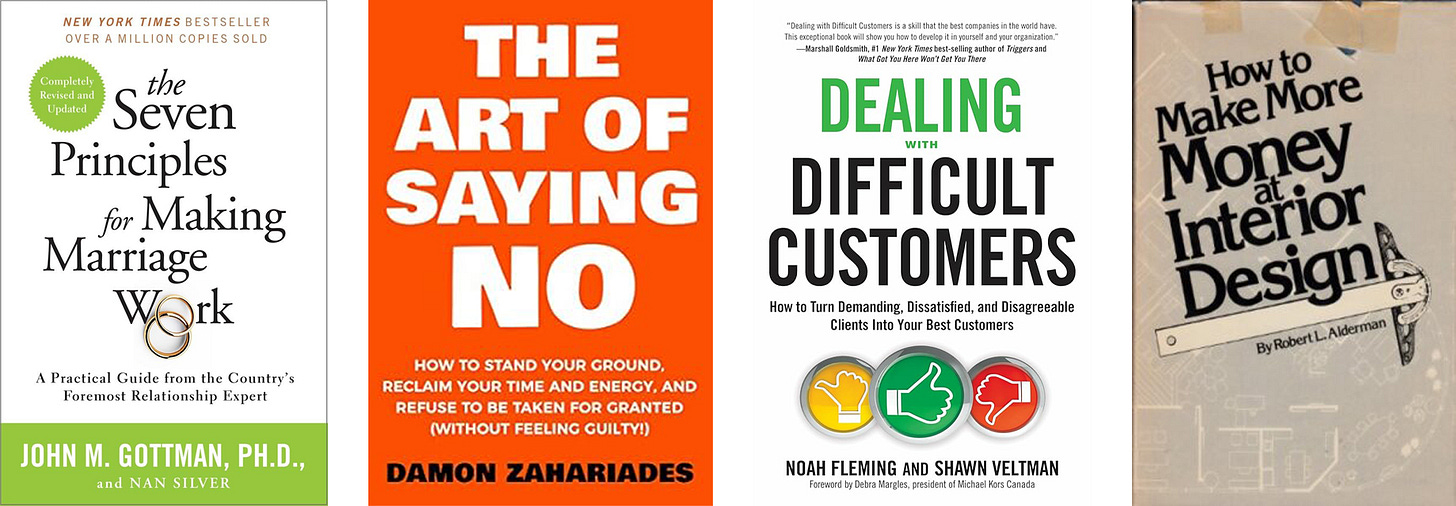Design School Didn't Prepare Me for This
A survival guide to accidentally becoming a therapist, supply chain detective, and miracle worker
I’ve been speaking to design students lately - first at Washington University, and just this week at Miami University (my alma mater). I love these conversations because I’m not there to lecture or pretend I have all the answers. I’m there to share the real, raw truth about starting creative brands - the messy, uncertain, beautiful reality of it all.
Design school taught me how to draft floor plans, and my night classes taught me how to lay out a clothing pattern. What it didn’t teach me was how to explain to a client why their “simple” request would require me to move mountains, bend time, and possibly perform actual magic.
After running both an interior design practice and a fashion brand, I’ve learned there’s a whole curriculum missing from design education. Consider this your crash course in the realities the professors somehow forgot to mention.
Timeline Expectations vs. Reality
What clients think: “Can you come over for an hour and just tell me everything I should do/change in my space?”
What actually happens: Being able to spit out some ideas actually requires me to measure every wall, window, and awkward corner to make sure my (hopefully brilliant) ideas actually fit in your space! I am the type of designer that needs to sketch as my first step. The last thing you want is a gorgeous room design that sounds amazing or looks wonderful on paper but leaves no room for that oversized sectional you’re in love with.
Drafting isn’t just pencil to paper - it’s solving a three-dimensional puzzle where every piece has to work with your existing architecture, your lifestyle, your budget, and the laws of physics. That “quick sketch” becomes detailed floor plans, elevations, and probably a few backup options because inevitably someone will realize they need the sofa to face the other direction after seeing the first design.
Plus, I have to factor in things like: Will that dining table actually fit through your doorway? Is there enough clearance around the island for two people to cook without bumping into each other? Can you actually reach the light switch from where you’ll naturally enter the room?
So yes, I can sketch a few ideas. But those sketches represent hours of measuring, planning, and problem-solving to make sure your beautiful new space actually works in real life.
The Real Cost of “Simple”
Customer: “It’s just a simple black dress. Why does it cost so much?”

The reality: That “simple” black dress is actually the most challenging thing to get right. As I was taught, the more simple the garment pattern, the more accurate it needs to be. There’s nowhere to hide imperfections when you strip away all the details.
When a dress has ruffles, pleats, or embellishments, small fitting issues get camouflaged. But a simple silhouette? Every seam has to be perfect. The shoulder line needs to hit exactly right. The drape has to be precise. One millimeter off in the armhole and the whole thing looks wrong.
Then there’s the fabric. A simple design demands better materials because the fabric IS the design. That black dress needs fabric that drapes beautifully, holds its shape, doesn’t pill after two wears, and photographs well. Premium fabric costs significantly more than fabric that just needs to look good from a distance.
Construction becomes critical too. Every stitch shows, so the sewing has to be flawless. The lining has to be perfect because you’ll see any bumps or puckers. The zipper installation needs to be invisible.
Simple doesn’t equal quick, and simple definitely doesn’t equal inexpensive.
That “basic” black dress represents hours of pattern perfection, premium materials, and meticulous construction. It’s not simple at all - it’s deceptively complex to make something look effortless.
Things That Will Make You Question Your Life Choices
Fashion edition:
Explaining why our dress costs $200 when “you can get one at Target for $20” (see above section about why simple isn’t simple)
Dealing with minimums: “What do you mean I have to order 500 buttons for a 12-piece collection?”
Your entire shipment gets stuck at a port in another country due to strikes, rolling blackouts, global pandemics…
Learning the hard way why we don’t produce domestically: When we were three buttons short on samples made in NYC, instead of using an identical button from their factory, they made us contact a local supplier, order a minimum of a dozen, and courier them same-day to their facility. Overseas, they would have just problem-solved and billed us for three buttons.
Interior design edition:
The sofa that was supposed to take 8 weeks shows up 6 months later
You fell in love with the perfect fabric that was listed “in stock,” placed the order, only to find out they closed the mill. You look for a replacement, cannot find the right match, and end up waiting 10 months until a replacement mill is found and production can begin again.
Explaining why moving one electrical outlet requires permits, an electrician, and possibly a small sacrifice to the home renovation gods
“While we’re at it, can we just knock out this wall?” - how small projects become whole-house renovations
The awkward silence when you reveal that the “simple” custom dining table they fell in love with costs more than their car
Client Communication: A Master Class in Diplomacy
What you want to say: “That’s physically impossible and also hideous.”

What you actually say: “That’s an interesting direction. Let me show you some alternatives that might achieve the same feeling while working with the structural limitations of reality.”
You become fluent in phrases like:
“That’s outside the scope of this project”
“We could explore that option” (translation: no)
“Let’s see what’s possible within your budget” (translation: absolutely nothing you just described)
The Supply Chain Awakening
Design school teaches you about color theory and proportion. It doesn’t teach you that your entire business can be held hostage by a factory in another country deciding to change their minimum order quantities, or that a backup vendor might interpret “navy blue” as “somewhere between purple and black.”
You’ll become an expert in phrases you never wanted to learn:
“Force majeure”
“Supply chain disruption”
“Extended lead times”
“Unfortunately, that item has been discontinued”
What Success Actually Looks Like
In school, success was a beautiful rendering or a perfectly executed project. In real life, success is when:
The client loves the final result (even after changing their mind 47 times)
Nothing caught fire during installation
You managed to make a profit despite everyone’s best efforts to prevent it
Your sanity remains mostly intact
The Skills You Actually Need
Design school should have included courses in:
Advanced Marital Counseling (when the couple looks to the designer to make their joint decisions)
Supply Chain Crisis Management
How to Say No Diplomatically
Emergency Problem Solving (also known as “Making Miracles Happen”)
Small Business Financial Management (or “How to Price Things So You Can Actually Eat”)
The Plot Twist
Despite all of this - the timeline chaos, the budget conversations, the material disasters, and the client requests that defy physics - I wouldn’t trade it for anything.
Because when it all comes together, when a client sees their space transformed or puts on a dress that makes them feel incredible, when all the behind-the-scenes chaos results in something beautiful and meaningful - that’s when you remember why you fell in love with design in the first place.
Even if nobody warned you it would require a degree in project management, a minor in psychology, and the patience of a saint.
Design school survivors - what reality check surprised you most? And potential clients - now you know why we ask so many questions and need so much time. We’re not trying to be difficult, we’re just trying to make beautiful things happen in a world that seems designed to prevent exactly that.






